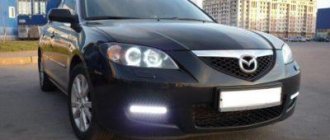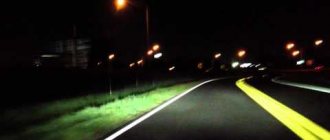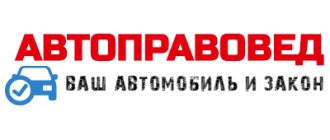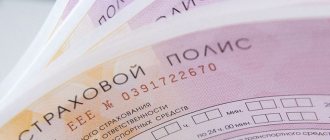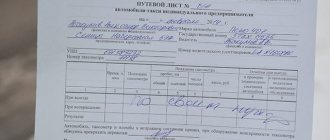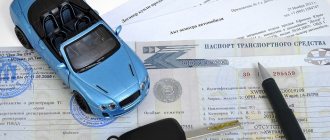Operating principle and properties of xenon lamps
In xenon lamps, the filament is replaced by two electrodes placed in a sealed glass flask with a mixture of xenon and metal salts. To create an arc discharge between the electrodes, an alternating current of 25 kW with a frequency of up to 400 Hz is required. When it passes through the gas, the ionization of electrons begins, and part of the energy released in this process is converted into light.
To install them in foglights, you need an ignition module, a reflector and lenses. The delivery set also includes headlight washers and auto correctors. This makes the design of headlights quite complex, but eliminates the main drawback - the ability to dazzle. For fog lights, the use of lenses can be considered a disadvantage - they do not allow the flow of light to dissipate.
What is special about xenon lamps?
The color temperature of sunlight is 5000K, while that of xenon lamps is 4300K, which is optimal for human eyes. Having a luminescence spectrum close to that of the sun, xenon lamps have a bluish tint, which also has a positive effect on perception. In addition, due to the high lighting power, xenon headlights provide a high level of safety, both in bad weather conditions and when it gets dark.
Pros and cons of xenon
Like any xenon lamp, it has advantages and disadvantages. Car owners value these sources for their powerful flow of light and glow temperature close to daylight (4000-7000 K).
There are other advantages:
- resistance to vibrations due to the absence of a filament;
- low energy consumption (compared to halogen);
- high efficiency;
- long service life (up to 3 thousand hours);
- heat transfer within 7%.
The disadvantages include:
- the need for an ignition unit and a set of high-voltage wires;
- light arc in the shape of the letter “C”;
- instability to voltage surges;
- dependence on external temperature;
- the presence of ultraviolet radiation in the glow, which forms a yellow coating on the plastic elements of the fog lamp;
- a sharp decrease in the efficiency of sources with high light temperatures in poor visibility.
Attention! The problem of the light arc is partially solved in Philips light bulbs. This company also supplies sources with quartz glass protection that blocks ultraviolet radiation.
Standard xenon installation
In theory, xenon fog lights are installed in the following order:
- receive a permitting expert opinion from a specialized organization (list on the page of the technical regulation department of the website of the Eurasian Economic Commission);
- contact the technical department at the traffic police with an expert opinion and a statement;
- contact a licensed car service center with an application for alteration (filling samples are available at the traffic police) and certificates for all parts;
- undergo a second examination;
- undergo technical inspection;
- visit the traffic police to get a mark in the documents.
How to avoid confiscation of rights for xenon?
There are several ways to avoid problems with the State Traffic Inspectorate. The simplest thing, of course, is simply not to install xenon in your car. If you still really want to drive a car with xenon headlights, then it is better to buy an inexpensive foreign car, the manufacturer of which has provided the possibility of installing xenon.
If this option is not suitable, then 2 more complex ones remain:
- Replace not only the lamps, but also the lenses themselves, as well as install tilt angle correctors and headlight washers. After this, the changes made must be registered with the traffic police. To do this, you will have to go a long way, which will also require financial costs. Here is a small algorithm for registering changes in the traffic police:
- obtaining a conclusion from a testing laboratory on the possibility of making changes to the car;
- obtaining permission from technical supervision to make changes;
- purchase of licensed parts and installation at a licensed service station;
- repeated maintenance;
- re-examination of the testing laboratory;
- obtaining a certificate of vehicle compliance with safety standards from the State Traffic Safety Inspectorate;
- receipt of changed STS and PTS.
- Another equally problematic method is to install xenon illegally and hope only for a fine under Part 1 of Art. 12.5. If you pay the fine within 20 days, then its amount will be only 250 rubles. If the inspector decides to draw up a resolution under Part 3 of Art. 12.5, then you will have to appeal this decision in court. The fact is that in this case the case is sent to court in any case, since only a judge can decide on deprivation of rights. You can read in detail about how and on the basis of what legal documents you can protect your rights and not lose your ID in the article “How to avoid a fine for xenon?”
Legality of installation
By law, the new xenon in the PTF can be installed in imported cars in which it is provided by the manufacturer. In any other situation, this is considered a modification to the vehicle's lighting design.
The legislative framework
There are no instructions in the traffic regulations regarding the use of xenon in PTF. According to paragraph 3.4 of the Technical Regulations, which determines the conditions for the approval of vehicles for operation, it is established that only lamps that correspond to their type must be installed in any headlights. According to clause 1.3.8. The flashlight marking must begin with the letter “D”. Cars like this are rare.
Attention! This means that xenon lamps are not required by law for any vehicles, so they cannot be installed.
The main reason is the need for a washer and auto-corrector. The luminous flux of most xenon sources is from 2000 lm, and according to paragraph 1.3.7. According to the technical regulations, these elements are mandatory for them. The washer and corrector can be omitted if the luminous flux is less than 2000 lm.
These are D8S and D6S bulbs with a power of up to 25 watts.
Responsibility for xenon in fog lights
The Code of Administrative Offenses does not separate headlights from foglights, so the punishment should be determined in accordance with paragraph 3.4 of Article 12.5. This is a fine or deprivation of rights for a period of six months to a year. The reason in practice is that the type of glow does not match the color. Most often, fog lights are confiscated.
Theoretically, white, yellow and orange xenon lamps, if they are installed in fog lamps, do not violate the requirements of the Technical Regulations if they do not blink and operate in two mandatory modes: constant and flashing.
Is it worth installing xenon in foglights?
Above we explained whether it is possible to install xenon in the PTF, and now we will discuss whether this is worth doing at all. There is no need to even discuss standard placement here - at the factory, lighting devices are adjusted correctly and as correctly as possible. In this case, you will not find any negative factors in the operation of gas-discharge lamps. However, if you install them yourself, as a result of incorrect settings, you may not only not feel the benefit, but even cause harm to yourself and others.
- The light from xenon inevitably scatters in all directions, while fog lights must shine downward to create a good view. It is extremely difficult to set the upper limit of light distribution in xenon fog lights, namely, what gives visibility in fog. Especially on Chinese xenon sources. As a result, instead of the road surface, you will see a white wall. And this is unsafe and pointless.
- Moreover, such light will blind both oncoming drivers and those driving parallel to you through the mirrors.
- And one moment. Fog lights, as you know, are located low on the body. In this position, bright light, even with the slightest unevenness of the road surface, creates strong shadows. As a result, the driver feels that there are deep holes ahead, so he drives slowly and irrationally.
That is why it is so important to correctly focus the light beams, direct them correctly onto the road surface and to the side, which is only possible in normal mode.
Well, we hope we have given a comprehensive answer to the question of whether xenon is allowed in fog lights in 2021. Our opinion, by the way, coincides with the normative-legal one. Replace xenon with LEDs or install good halogens. The first ones provide the necessary pleasant diffused light, by the way, no less bright, while the second ones are time-tested.
How to communicate with a traffic police inspector if you have xenon installed
If a car with xenon fog lights is stopped by a traffic police officer, you need to:
- ask to present a full ID and copy down the data;
- To stop a car, compelling reasons are required (Order of the Ministry of Internal Affairs No. 185), the presence of a xenon bulb can only be determined visually;
- in order to determine the type of light source, it is necessary to open the hood; during an inspection, video recording and 2 witnesses are required (part 1 and part 2 of article 27.9 of the Administrative Code);
- before signing the protocol, in the line “Responsibilities and rights explained,” you should indicate that they were not explained (if this is true);
- in the “explanation” line, indicate “I do not agree with the violation, I require a lawyer.”
Important! A traffic police officer does not have the right to send a car to a parking lot. Stopping for inspection is prohibited in the same places where it is prohibited by traffic regulations.
Let's sum it up
Fog lights are very effective in poor visibility conditions and have positive qualities that headlights do not have. Fog lights shine low, their light literally spreads along the road and provides excellent visibility in the area of the nearest 10-15 meters. Another positive distinctive quality of PTFs is that they provide a clear cut-off line, which seems to cut through the fog and allows the driver to better navigate the road and assess the distance to obstacles. But!!! If your car has xenon installed in the PTF, you will most likely be deprived of all of the above benefits! Bright, unregulated xenon in the fog lights shines anywhere - on birds, illuminates the side of the road, blinds oncoming cars, but not under your own wheels. Before installing xenon in fog lights, think carefully and take into account the above. If you don’t want to have problems with traffic police officers, don’t want to be deprived of your license, and you don’t give a damn about other road users, refrain from installing xenon in fog lights. If you really want to install xenon bulbs, then entrust this work to a professional who will not only select the right bulbs of the required power, but upon completion of the installation work will adjust the PTFs so that they do not blind other motorists and are as effective as possible for you.
That's all for me, thank you for your attention and see you again at Fara. If you have anything to add to the above, feel free to share your thoughts on this topic using the comment form. Take care of yourself and your car. Bye!
Main conclusions
If the design of the vehicle does not provide for xenon in foglights, there is no need to rush to install it. These gas discharge lamps require lenses to focus the beam in one direction. This defeats the main purpose of the fog lights. If you install a lamp without lenses, the flow of light will be limited only by the design of the device; it is impossible to set the upper limit. This may lead to an accident due to reduced visibility.
Attention! Yellow xenon is suitable for driving in light fog and cloudy weather. Therefore, manufacturers producing xenon foglights call them additional.
When purchasing xenon, you should not choose products with temperatures exceeding 6000 K. Their light quality is lower. If one headlight fails, you need to install two new ones at once, since the temperature of the old one will not be the same as the new one.
You should not install fog lights yourself. If the kit is incorrectly selected or the slightest error during the installation process, the light flux will be directed incorrectly. If you make a mistake when installing the ignition unit, there is a high probability of a short circuit.
Previous
Car light Review of the best lamps for cars with H11 socket
Next
Car light LED lamps for cars: characteristics, types, review of manufacturers and selection tips
Several aspects of one question
This year, violators of the light regime will continue to face threats for illegal installation of lighting equipment.
The legislation also applies to the following types of violations:
- lamps with an inert substance are installed in fog lamps, which implies a negative answer to the question whether xenon can be installed in fog lamps;
- xenon is present in the spotlight installed on the roof of the car;
- the driver’s ignorance of the xenon emitters installed on his four-wheeled vehicle.
This is due to several reasons:
- Registration of the vehicle by the new owner involves checking the technical serviceability of the car. Detection of xenon in headlights or sidelights may result in refusal of registration, including deprivation of a driver’s license and the imposition of an obligation to eliminate the identified deficiencies.
- Even if the police do not find anything like this, then all responsibility for electrical appliances falls on the shoulders of the new owner of the car. Therefore, before purchasing a used product, you need to check it.
Pre-identified problems will help the future owner save on re-equipment of devices and avoid liability for the illegal installation of additional equipment.
Unauthorized installation of lighting devices with xenon or bi-xenon is prohibited by law. Installation of such equipment is carried out by specialized organizations after collecting a certain package of documents.
Ignoring the rules is punishable by a ban on driving a car for a certain period through deprivation of rights. The legalization of gas-discharge lamps by entering information into the technical passport of the vehicle will help prevent unpleasant showdowns with the traffic police.
Post Views: 2

